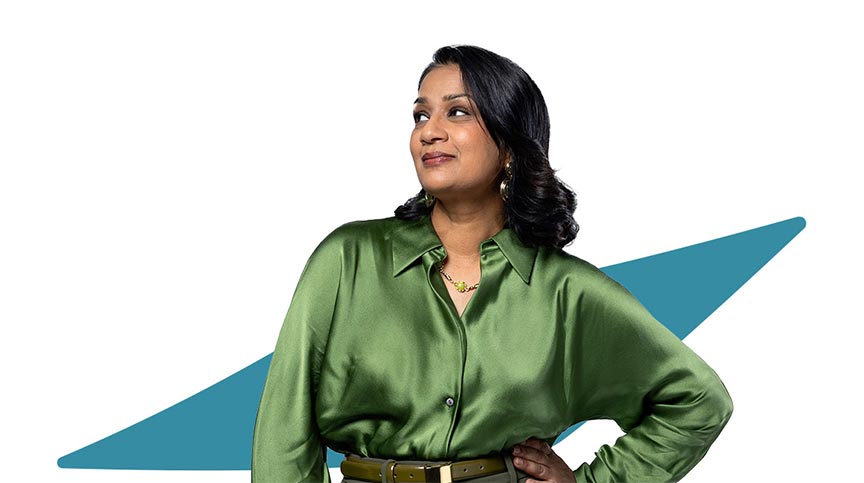Tips to Facilitate Leadership Conversations Using Pictures
What do military generals, engineers, scientists, and Type-A professionals all have in common? A reputation for being serious-minded, taking a no-nonsense approach to their work, and an affinity for visual thinking.
Visual thinking uses pictures and images to evoke ideas, thoughts, and feelings, and to foster powerful conversations.
At CCL, we are firm believers in visual thinking processes, and we use them often with our faculty, facilitators, and clients.
But we’ve found that in a typical workplace, the most verbal people, or the person “in charge,” often dominates discussions.
Using pictures can help change the conversation, shifting typical patterns, diffusing tension, and engaging everyone — because getting people to talk isn’t hard, but getting people to talk in-depth with reflection, honesty, and clarity can be. There must be an environment of psychological safety for truly candid conversations.
If you’re facilitating a group discussion, workshop, or leadership training, and want to help move the discussion from the current challenge to a better future, our practice of “putting something in the middle” can be helpful. Also called mediated dialogue, it’s an effective way of leading people through change and facilitating important, typically difficult conversations in a way that’s safe, creative, and very effective.
When we first started with this practice, we were concerned that using pictures to facilitate conversations might be viewed as frivolous or a waste of time by highly analytical or no-nonsense people.
But after using pictures to facilitate leadership discussions with people from all walks of life and around the world, we’ve actually found the opposite: this practice is generally understood by even the most linear, logical, and pragmatic personalities as an effective way to cut to the heart of an issue and uncover multiple solutions. It can be the starting point for talking about complex or difficult things, enabling understanding from a variety of perspectives.
How can you jump-start visual thinking in your own team or group? Here’s how to use pictures to lead effective conversations in group discussions or at leadership trainings or workshops.
How to Facilitate Effective Leadership Conversations Using Pictures
A Step-by-Step Guide
First, you’ll need a selection of images.
Focus less on having the “right” images, and more on having a wide range of choices. You can use our Visual Explorer® card set if you like — a pack of diverse and interesting images and a guide for how to use them as a facilitation tool — or simply postcards, photos, clippings from magazines, or images from other sources.
When facilitating a discussion in person, the leadership pictures should be arranged around a room, on tables, or in decks of “cards” to sort through. For virtual discussions, you can send out a link to a shared set of images that people can scroll through.
Then, ask a “framing” question.
Decide in advance how to frame the discussion. Think about the challenge, situation, or complex idea you need to address in your team or organization, and consider the context of the session. You’ll want to frame the topic for participants in terms of a question, or a pair of questions, such as:
- What are our strengths? What are our weaknesses?
- What do you see as our biggest challenge? What will it look like to solve this challenge?
- What does leadership look like now in our organization? What will leadership need to look like for greater success?
- What behaviors will help drive the business strategy?
- What’s getting in our way?
- What stands out in the data we just reviewed?
- What are the possibilities we see in this situation?
- How do you feel about this at a gut level?
- What are we missing, neglecting, or underestimating?
- Where have we been? Where are we going? To what do we aspire?
- What problem are we trying to solve? What will our organization look like if we solve it?
- What if one of our key assumptions is wrong, or backward?
- How would we do this if we had unlimited resources? If we had no resources?
Next, write about it.
Ask participants to take a few minutes to think about the question. Invite them to reflect on their perspective on the issue or challenge. They can jot down some initial thoughts and reactions — bullet points, journaling, or whatever works.
Then, turn to the images.
Without speaking (though some background music can be nice), have everyone browse through the available images and choose the one that depicts the problem or issue for them. Ask people to choose a picture that reflects or relates to what they’re thinking and feeling about the question or challenge. If you’re doing a comparison or paired question, instruct everyone to pick a leadership picture for each question.
You may want to offer a guideline like, “Pick as many cards as you like, and as few as you need.” Let them know they don’t need to overthink it; if they’re drawn to an image and aren’t sure why, that’s okay. They should just go with it.
Tell them to look closely.
Once they’ve selected an image, ask them to pay close attention to the details. What’s there? Ask them to write down as much as they can to describe the leadership picture and connect it to the framing question.
Talk about it.
The discussion begins with group members taking turns sharing what they see in their picture and why they chose it. People can do this in pairs with a partner, or with the larger team or group. Ask someone to describe the image they selected. First, they should explain what they see, then talk about why they chose that picture. At first, the others need simply to listen. After a few minutes, ask others what they see in the picture. Each person will then repeat the process.
Consider: So What? and What If?
The conversation then shifts to finding commonalities and differences, sharing insights, and offering ideas. The group can discuss questions like:
- What did you learn from the images and the process of talking about them?
- How was it helpful?
- What was surprising?
- What was commonly shared?
- What were the key differences?
- What if you used these insights as you addressed the problem or challenge?
- What will you do now?
We expect you’ll find this process of using pictures in trainings or workshops to give people tools to show effective leadership and hold more candid conversations very helpful. We’ve used this facilitation method with CEOs and senior leadership teams, generals and State Department officials, nonprofit leaders and entrepreneurs, young people and educators, and consistently find that the practice of “putting something in the middle” is a way of facilitating important, typically difficult conversations in a way that’s safe, creative, and very effective.
Ready to Take the Next Step?
Want to try using leadership training pictures to facilitate more powerful, productive conversations at your organization? Check out our world-class Facilitation Tools, including our widely used Visual Explorer® — a set of more than 200 photographs and art prints.











